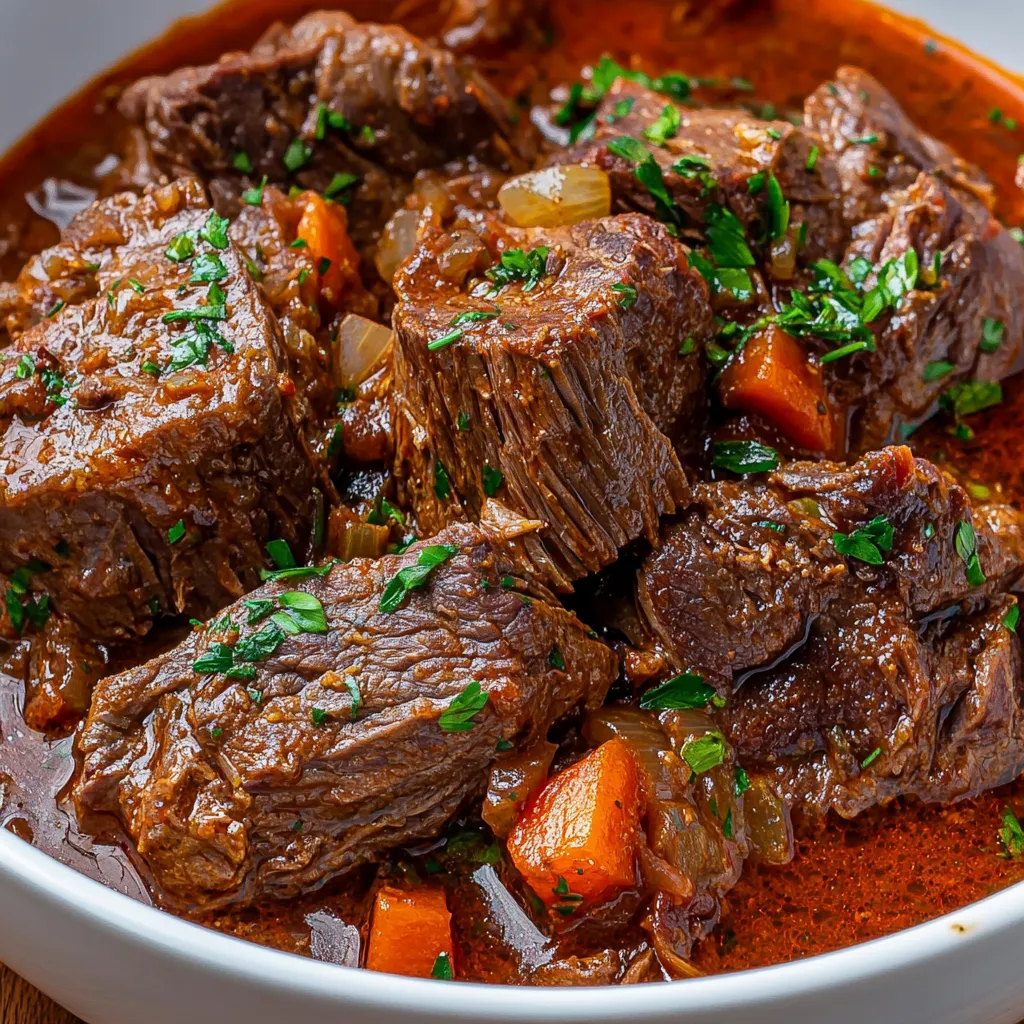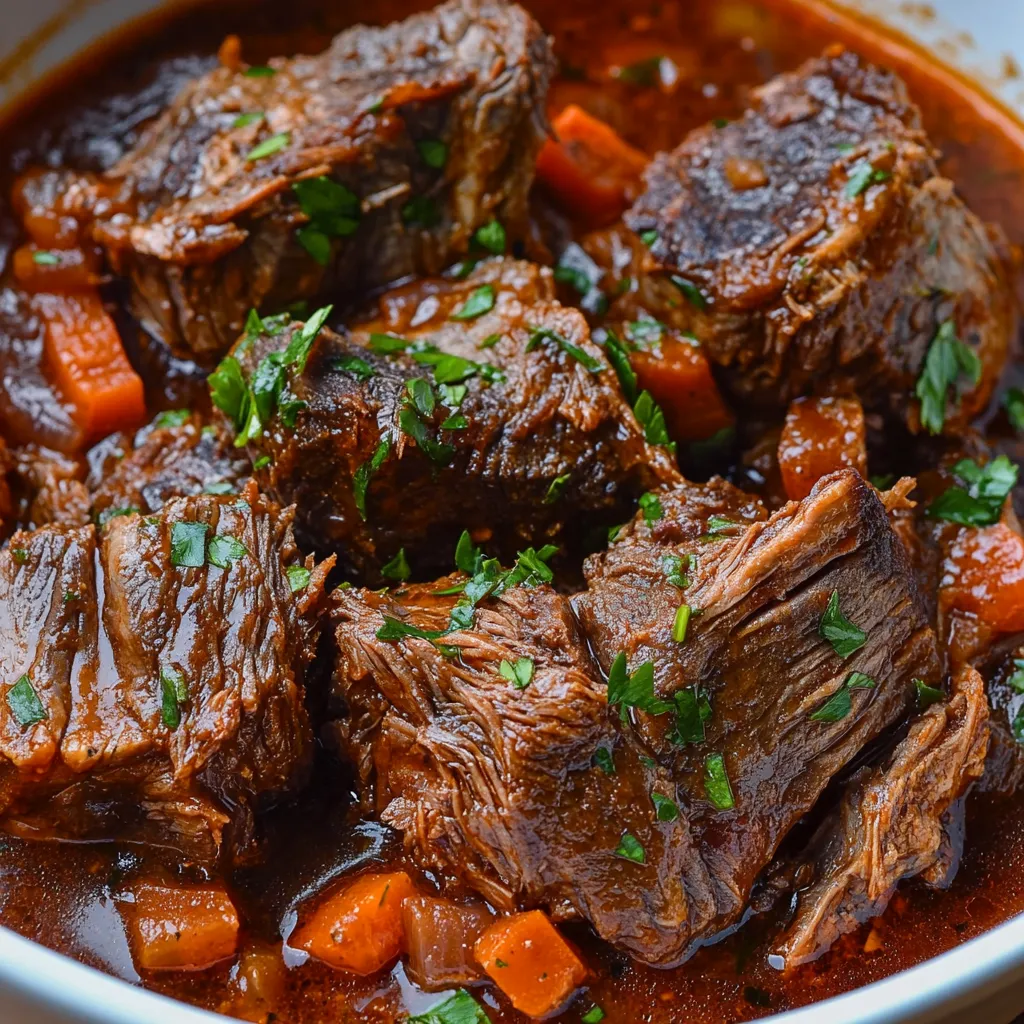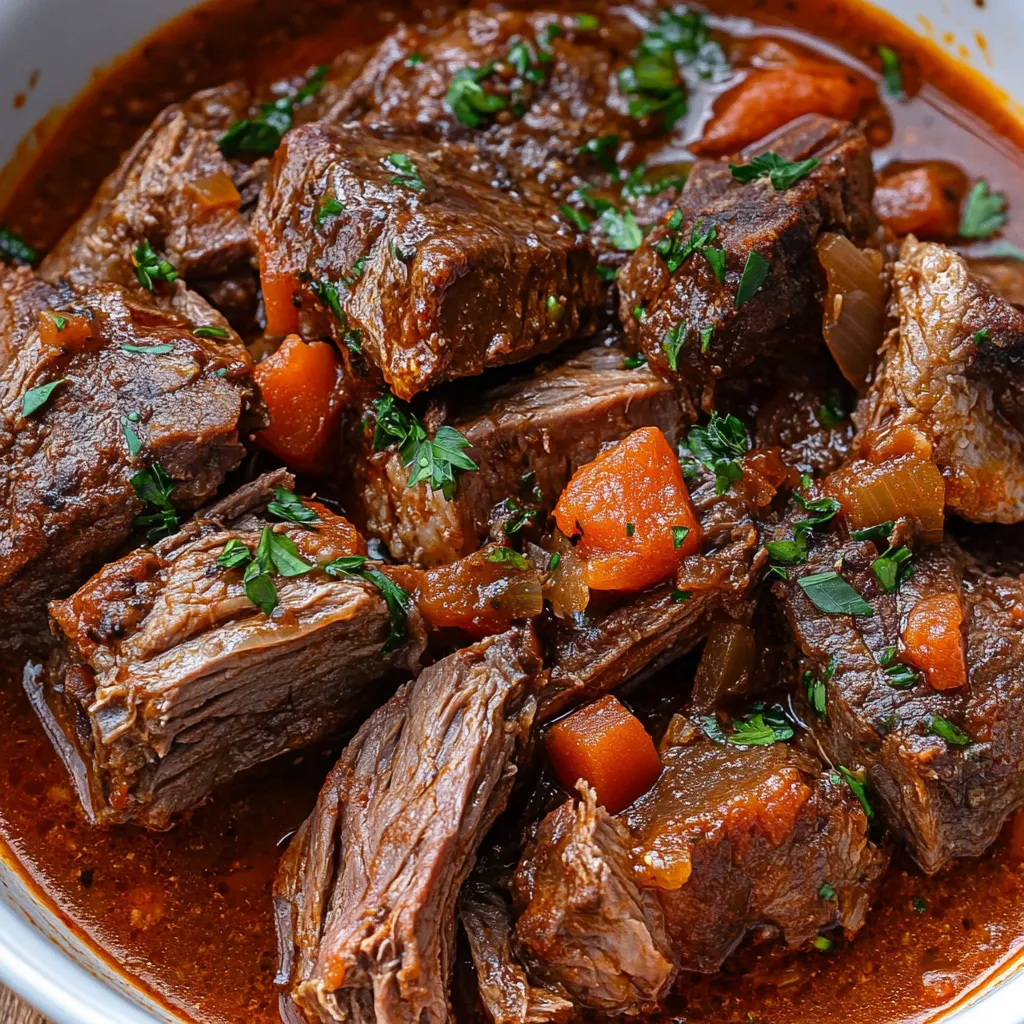 Save
Save
Tuscan-style beef roast, traditionally called "stracotto," turns a budget-friendly beef cut into something incredibly special through low and slow cooking. This homey dish blends fall-apart beef with a flavorful tomato sauce packed with veggies and herbs. Compared to American-style pot roast, this Italian take adds the bright tang of tomatoes and a richer herb blend, making a sauce so good you'll want to mop up every bit with bread or creamy polenta.
I first tried making this after eating at a tiny family restaurant in Tuscany where I had the best beef roast ever. The owner told me stracotto literally means "cooked too much" - but in the best way possible. My first try at home wasn't quite right - the gravy was too watery and the meat wasn't soft enough. After trying a few more times and cooking it much longer, I finally got that velvety sauce and meat that falls apart with just a touch. Now it's what I cook whenever the whole family gets together on Sundays.
What You'll Need
- Chuck roast: This fatty cut gets super tender during long cooking; grab one with good marbling throughout for maximum taste
- Bacon or pancetta: Adds a base of smoky richness; go with pancetta for a more Italian flavor, though thick bacon works great too
- Onion, carrot, and celery: This trio (known as "soffritto") starts the flavor magic; cut them all the same size so they cook evenly
- Garlic: Brings essential flavor depth; chop it small to get the most taste out of it
- Crushed tomatoes: Try to find San Marzano ones for the best mix of sweet and tangy; their thickness helps make a rich sauce
- Beef broth: Adds meaty flavor; homemade is fantastic, but a good box version with low salt works too
- Fresh herbs: Rosemary and thyme give wonderful aroma; fresh ones taste brighter, but dried will do in a pinch
- Italian seasoning: This mix usually has oregano, basil and marjoram, giving that classic Italian taste
- Red pepper flakes: Adds just a bit of heat in the background; add more or less based on what you like
How To Make It
- Cook the bacon right:
- Start by slowly cooking the chopped bacon or pancetta in a heavy pot over medium heat, giving it a stir now and then until the fat melts and the bits get crispy. Take your time with this - about 5-7 minutes - to get all the flavor without burning it. Scoop out the crispy pieces with a slotted spoon, but keep all that tasty fat in the pot as your flavor base.
- Get the beef nice and brown:
- Dry your beef completely with paper towels, then sprinkle plenty of salt and pepper all over. Heat up the bacon fat until it's hot, then carefully put in the beef pieces. Let each side get really brown before flipping - about 4-6 minutes per side. Don't move it around too much! That deep brown crust adds tons of flavor to the whole dish.
- Build your flavor base:
- After taking out the browned beef, turn the heat down to medium and toss in your chopped onion, carrot, and celery in the same pot. As they cook, they'll release moisture that helps scrape up all those tasty brown bits from the bottom. Cook until everything softens and onions look clear, stirring occasionally for about 7-10 minutes. This mix creates the foundation that flavors the whole dish.
- Add the aromatics:
- Throw in your chopped garlic and red pepper flakes, stirring constantly for about a minute until you can really smell them but before they brown. Watch carefully here - garlic burns quickly and gets bitter, so keep it moving in the pan.
- Make the cooking liquid:
- Pour in the beef broth, using it to scrape up any stuck bits from the bottom. Add your crushed tomatoes, herbs, bay leaves, and the crispy bacon you set aside. This mix creates a super flavorful liquid - meaty from the broth, tangy from tomatoes, and fragrant from the herbs. Stir everything together well.
- Cook it low and slow:
- Put the browned beef back in, nestling it into the liquid. It should be partly covered but not completely underwater. Pick whatever cooking method works for you - stovetop, oven, or slow cooker - but remember the real magic happens with low heat and lots of time. The tough parts in chuck roast need hours to break down, which gives you that melt-in-your-mouth texture.
- Check if it's done the right way:
- Instead of just going by time, stick a fork into the thickest part of the meat. When it's perfect, the fork should slide in super easily, and the meat should pull apart without much effort. This usually takes 3-4 hours in a 275°F oven, but might be different depending on your meat.
- Finish it with care:
- When it's done, take out the bay leaves and add more salt and pepper if needed. Let the whole thing rest for 15-20 minutes before serving. This gives the meat time to soak up more juice, making each bite more flavorful and tender.

My nonna always made her stracotto a day ahead, saying it needed time to "sleep and dream" in the fridge overnight. I thought she was just being superstitious until I tried it myself. The flavors really do get better after sitting overnight. Now I often make mine ahead too, especially when we have guests. Plus, you can easily scrape off any hardened fat from the top before warming it back up.
How To Serve It
What's great about Italian beef roast is how many ways you can serve it. The classic way is over smooth, creamy polenta, which soaks up all that rich sauce perfectly. The combo of silky polenta with chunks of tender beef creates an amazing texture contrast that's really satisfying.
For something more rustic, try it with roasted potatoes tossed with rosemary and garlic. The crispy potatoes match so well with the soft meat. In winter, I love pairing it with a simple risotto - the creaminess goes perfectly with the hearty sauce.
Always have some crusty Italian bread on the side. There's something so satisfying about using bread to soak up the last bits of sauce on your plate - Italians call this "fare la scarpetta" (making the little shoe), and it's the biggest compliment you can give to the cook.
Different Ways To Try It
While this basic version tastes amazing as is, I've played around with some tasty twists over time. For a Tuscan spin, toss in a handful of pitted Kalamata olives and a spoonful of capers during the final hour of cooking. These tangy additions really complement the rich sauce.
For special dinners, I sometimes add dried porcini mushrooms that have been soaked in hot water. I add both the chopped mushrooms and their soaking water to the pot. This creates an even deeper flavor that mushroom fans will love.
Around the holidays, I like to add warmth by throwing in two strips of orange peel and a cinnamon stick with everything else. These subtle additions create a festive twist that fits the season without taking over the dish.

Final Thoughts
I've been tweaking this dish for over fifteen years now, ever since that amazing meal in Tuscany. What makes it special isn't fancy methods or hard-to-find ingredients, but patience and honoring tradition. There's something really satisfying about the whole process - slowly building flavors, watching a simple cut of meat turn into something wonderful. When my home fills with the rich smell of this simmering pot roast, my family always gathers in the kitchen, waiting for dinner. That's probably the best part of cooking - creating moments together around food made with care and love.
Common Questions About This Recipe
- → Which beef cut works best for this dish?
- Chuck roast is great because it’s marbled and softens beautifully with slow cooking. Brisket, round roast, or even short ribs are solid alternatives.
- → Can I use a pressure cooker or Instant Pot?
- Sure! Brown the meat and veggies first, then pressure cook on high for 60-70 minutes. Once done, reduce the sauce using the sauté function.
- → When is the pot roast ready to eat?
- When the meat shreds easily with a fork, it’s ready. If it feels tough, let it cook a bit longer.
- → What are good side dishes for this meal?
- Traditionally, it goes with polenta, pasta like pappardelle, or mashed potatoes. A crusty bread and simple salad also go wonderfully.
- → Is it okay to make this ahead of time?
- Definitely! The flavors improve the next day as they blend. Store it in the fridge overnight and reheat on the stove or in the oven at 325°F.
